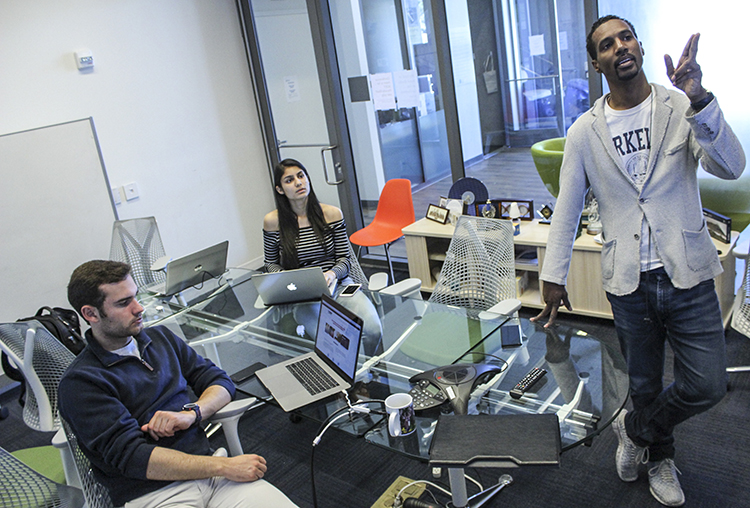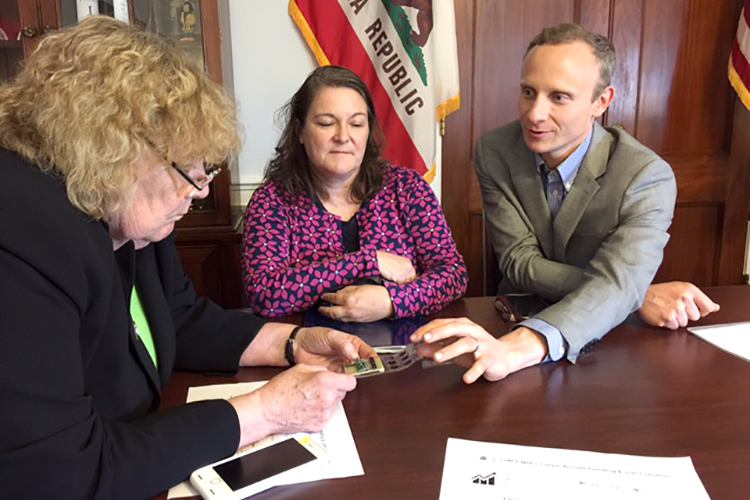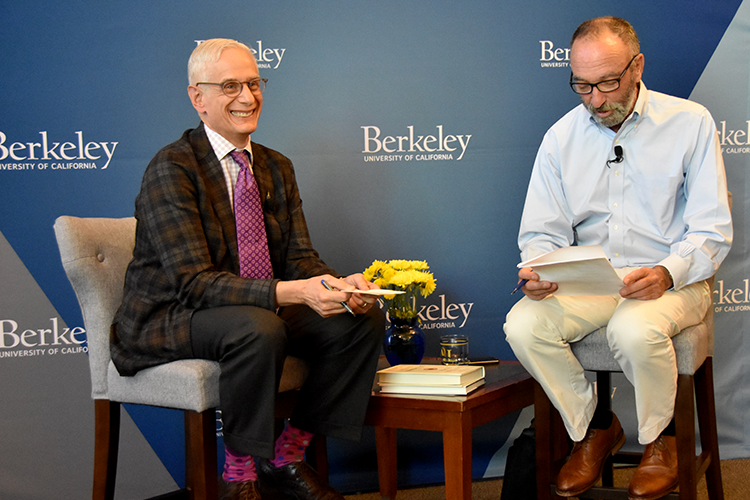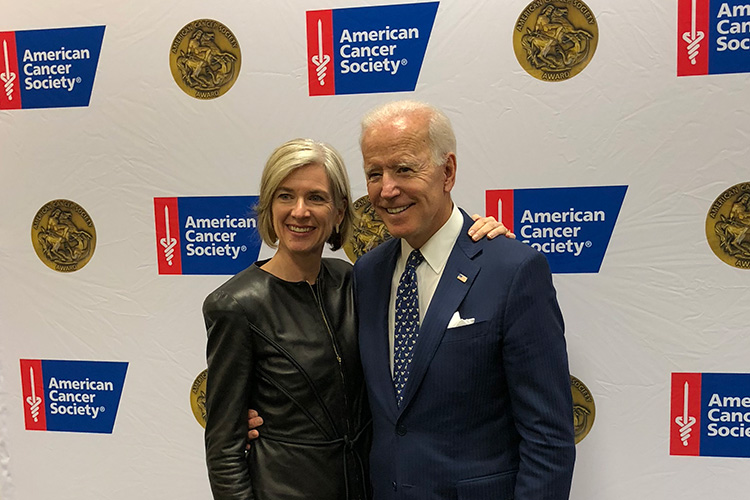Berkeley’s renegade history fuels its rise to the top in startup competition
A new survey from Crunchbase News shows Berkeley's push to be a leader of innovation is paying off
June 12, 2019

Caroline Winnett, executive director of UC Berkeley’s SkyDeck, is one of many who say the university’s history of challenging the status quo has led to its clear dominance in having students and faculty successfully produce funded startups (UC Berkeley photo)
UC Berkeley is renowned for its history of rebellion, upsetting the status quo and stretching the limits of the way things ought to be.
That reputation, when viewed from the outside, has often been seen as negative. But a new ranking listing Berkeley as the No. 1 public school in the world for funded founders — business and tech startups that attract funding almost from inception — suggests Berkeley has turned those qualities into positives.
According to Crunchbase News’ recent 2019 listings for funded founders who, by the time they had graduated had raised at least $1 million, Berkeley had 240 founders. UCLA came in second, with 85. And, in fact, it takes combining the second-through-fifth ranked schools — UCLA, Michigan (76), Illinois (63) and Washington (61) — to get to Berkeley’s level.
“Berkeley is the original question-the-status-quo, do-disruptive-thinking place,” says Caroline Winnett, executive director of Berkeley SkyDeck, the hub of the university’s startup machine. “I like to say that we don’t just think outside the box. There is no box.”
Does this mean Mario Savio, the People’s Park protesters and the Third World Liberation Front are at the heart of Berkeley’s current surge of innovation?
Well, yeah.

Startup With Purpose members Henry Keenan, left, Avdeep Dhillon, center, and Jarrett Wright at the Sutardja Center for Entrepreneurship and Technology Stadium Space in April of 2018. (UC Berkeley photo by Jeremy Snowden)
“For a lot of startup ventures, it’s a lot more about your mindset and your behaviors than it is about the pure logic of the company or the plan,” Ikhlaq Sidhu says. Sidhu, the faculty director and chief scientist at Berkeley’s Sutardja Center for Entrepreneurship & Technology (SCET), has spent the last 15 years mining the College of Engineering for startups.
“Berkeley’s true underlying cultural characteristics line up very well with entrepreneurship and newer ventures,” Sidhu says. “A characteristic of Berkeley comes from the Vietnam War and the ability to protest and to stand up for something that people believe in. If they believe, and they are willing to protest, it’s a rebellious attitude, and one that is actually the exact same characteristic that startups come from.”
UC Berkeley has a long history of startup success. In 1971, Steve Wozniak took a leave from Berkeley for a year to earn money for college. He and buddy Steve Jobs founded Apple Computer in 1976, and he later returned to Berkeley to get his B.S. in electrical engineering and computer science in 1986.

UC Berkeley’s Eric Munsing, right, and Rhonda Shrader of the Berkeley-Haas Entrepreneurship Program, center, met with Rep. Zoe Lofgren in May 2017, when Munsing was trying to get his electric-car startup company going. (UC Berkeley photo)
“This is a good breeding ground for startups and has been for a long time,” Rhonda Shrader, executive director of the Berkeley-Haas Entrepreneurship Program, says. “People who come here want to question, not because they feel entitled. They are scrappier. I love that about Berkeley. It’s an unsung reason why Berkeley is such a great place.”
UC President Janet Napolitano and Berkeley Chancellor Carol Christ have been pushing the Berkeley-as-startup-incubator narrative for the past several years. Napolitano has said that, for the 10-campus system, innovation has to be a priority.
Christ says that, when she returned to Berkeley in after spending 10 years at Smith College as president, “one of the things I was struck by was the vastly heightened level of interest in entrepreneurship.”
“The campus community has responded to this shift by institutionalizing support for innovation and entrepreneurship on and near our campus,” the chancellor says. “We’ve been investing in startup resources such as our incubator SkyDeck, CITRIS Foundry, the Venture Lab, and classes dedicated to teaching entrepreneurship.”
One of Christ’s first moves as chancellor was to tap Randy Katz for the job of vice chancellor for research.

UC Berkeley professor
Alice Agogino (center), started a robot company, Squishy Robotics, at Skydeck, a startup incubator on campus. (UC Berkeley photo by Keegan Houser)
His role is to try to bring together all the disparate pieces of the startup game at Berkeley — ideas, innovation, funding, research, compliance and outreach to industry. There are more than four dozen campus research units, a dozen research museums and remote field stations and the research administration offices that need to move in the same general direction.
“That Berkeley has been recognized in this way is extremely significant,” Katz says. “You have to understand where Berkeley was 10 years ago. We had great science and engineering, but where Stanford had helped spin out Silicon Valley, we didn’t have much of a reputation in that area. It’s not like we were Avis (car rental) to Stanford’s Hertz. We were like Budget or Dollar. But as this study shows, in the last 10 years Berkeley, has become a world player. As industry has matured, statistical techniques and data analysis have more and more come from Berkeley.
“And if you look at the kind of work that Amy Herr has done in bioengineering and medical technology and look at what Jennifer Doudna has done in gene editing with her CRISPR work, you see how important Berkeley has become.”
Herr, who has been at Berkeley for a dozen years and who says the last eight or so years have seen the visibility of the campus “come out of the closet,” says she wasn’t surprised by Berkeley’s leadership role, or by how big the gap is between Berkeley and the second-ranked university.
“Sometimes, I think there are some in our administration who don’t realize just how much we are crushing it,” Herr says. “This shows that. Berkeley students have become alumni. And Berkeley alumni have become leaders. A big thing for us, and I don’t mean to sound curt, is that I just try to stay out of the students’ way. They are trying to create the future their own way, and they are. This is a contribution to society at a big level.

Vice Chancellor for Research Randy Katz, left, here being interviewed by Dan Mogulof, has an expansive vision for research on the UC Berkeley’s campus. (UC Berkeley photo by Hulda Nelson)
“When I came here, I never saw myself as an entrepreneur, but we have people here who can demystify the process. And if a student thinks, `I can do this,’ then it’s going to spread to a lot of our students.”
Fyodor Urnov, genetics researcher at the Innovative Genomics Institute (IGI), underscores the significance of being able to reach across different areas of interest at Berkeley by telling the story of how a conversation across specialties led to one of this century’s biggest innovations in biomechanics.
Earth scientist and microbiologist Jill Banfield met in 2012 with Doudna at the Free Speech Movement Café in Moffitt Library. Banfield was working at the time on bacteria, and she wanted to get Doudna’s take on a curious repeating pattern she’d detected in cells. Doudna and her team explored the phenomenon. With the help of seed money from Berkeley’s Lab-Directed Research and Development (LDRD), the university’s CRISPR program bloomed.
Today Berkeley is the center of the gene-editing universe.
“It was a case of chance favoring the prepared mind,” Urnov says. “To me, it shows that the fundamental Berkeley system is an incredibly fertile ecosystem. It begets translatable innovation.
“CRISPR is by far the most exciting innovation of my professional life. The next CRISPR is incubating somewhere in a Berkeley lab. I can’t tell you where, but I know it’s out there.”

Jennifer Doudna, left, and former vice president Joe Biden each received a Medal of Honor from the American Cancer Society on Oct 18, 2018. Doudna was honored for her breakthrough CRISPR work at UC Berkeley. (Photo courtesy of the American Cancer Society)
It’s that possibility that is bringing funding money to these Berkeley startup founders.
And if Winnett’s vision is correct, the flow of money into Berkeley could increase dramatically as these funded startups get going and as some of them find a marketplace.
SkyDeck is rare in a university setting in that it brings in enough income that “we are mostly self-funded,” Winnett says. The basic plan of finding startups, helping them get the funding and other support they need and getting them to market means income to the university once they are acquired or go public.
The Berkeley SkyDeck Fund is a private venture capital fund like any other, except that it has a cooperative agreement with the university. The fund will only invest in companies accepted into SkyDeck’s accelerator program. The fund and the university both share half of the fund management profit.
There were approximately 50 companies applying to SkyDeck’s accelerator program in 2015. This year, the number is 800.
The Berkeley SkyDeck Fund’s first funding goal was set at $10 million. The response was terrific, and the fund was closed at $24.5 million. UC Berkeley has not put any money into the fund.
“This is a very deep partnership,” Winnett says. “Bringing money back to the university is at the core of what we do. Ultimately, it could mean a lot for the university. We want to find the next Apple, the next Google, the next Facebook. As our fund matures, and as more funds are raised in the future, we think there is a chance to bring in big money to the university.
“I’m not talking a few million here or there. I think it is possible over the life of these funds we could see a billion dollars coming through our hot little hands as a new source of funding for education.”